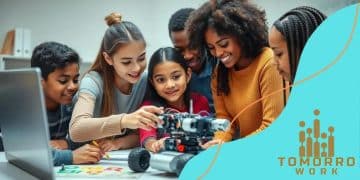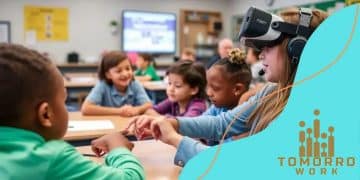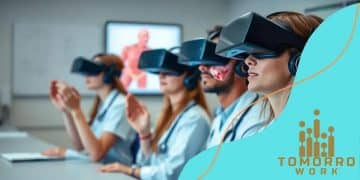How AR is being used for hands-on learning experiences
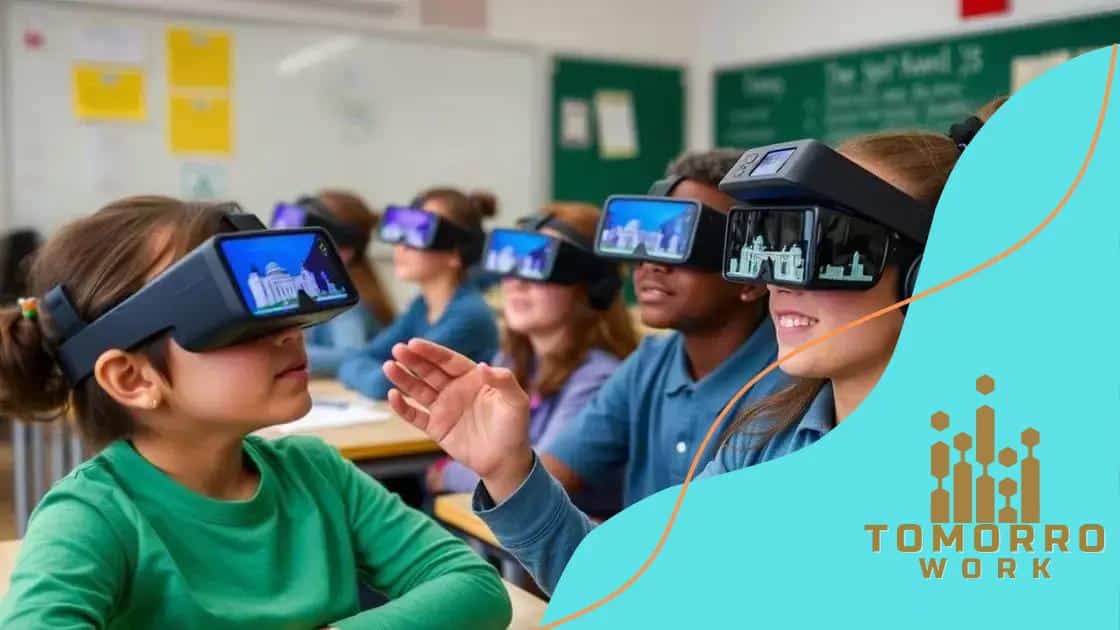
Advertisements
Augmented reality (AR) is transforming education by enhancing student engagement, facilitating interactive learning experiences, and providing personalized educational opportunities through innovative technology integration.
How AR is being used for hands-on learning experiences is reshaping the educational landscape. Imagine exploring ancient ruins or conducting science experiments without leaving your classroom. Intrigued? Let’s dive in!
Advertisements
Understanding augmented reality in education
Augmented reality (AR) is a groundbreaking technology that enhances our interaction with the world around us. In education, it brings subjects to life, making learning more engaging and interactive. By overlaying digital information on the real world, AR provides students with immersive experiences that deepen their understanding.
What is Augmented Reality?
AR combines the physical and digital worlds, allowing users to experience enhanced environments through devices like smartphones or AR glasses. This technology can transform ordinary lessons into extraordinary experiences, providing visualizations that aid comprehension.
Benefits of AR in Education
Integrating augmented reality into classrooms offers numerous advantages:
Advertisements
- Increases student engagement
- Enhances retention of information
- Encourages collaboration among students
- Provides opportunities for personalized learning
With AR, students can explore complex concepts by seeing them in three dimensions. This approach not only caters to visual learners but also stimulates their curiosity and creativity. For instance, a biology class studying human anatomy can view a 3D model of the heart, allowing them to interact with and better understand its structure.
Furthermore, AR tools promote critical thinking and problem-solving skills. As students manipulate digital objects, they learn how to approach challenges from different angles. This hands-on experience is invaluable in nurturing essential skills for their future.
Real-World Applications of AR
Many educational institutions have started implementing augmented reality technologies:
- Field trips that bring historical sites to life
- Science experiments that simulate real-world scenarios
- Art lessons that enable students to visualize their ideas directly
The use of AR extends beyond traditional subjects. Language learners can engage with interactive vocabularies, allowing for practical use in daily conversations. This versatile tool adapts to various learning styles, providing tailored educational experiences.
As we immerse ourselves in this AR-enhanced education, it’s clear that the future holds exciting possibilities. The technology continues to evolve, paving the way for even more innovative learning methods that can transform the educational landscape.
Benefits of AR for hands-on learning
Augmented Reality (AR) offers numerous benefits for hands-on learning, making education more engaging and effective. By incorporating AR into the classroom, teachers can capture students’ attention and enhance their learning experiences.
Enhanced Engagement
One of the most significant advantages of AR is its ability to boost student engagement. Learners are more likely to pay attention when lessons come alive in 3D. Interactive experiences help foster a love for learning, making educational content more appealing.
Improved Retention
When students interact with digital elements in real-time, they are likely to retain information better. For example, a lesson on the solar system can involve students manipulating 3D models of planets, which aids in memorization. This active learning approach enhances understanding and memory retention.
- Increased participation in classroom activities.
- Visualizing complex concepts makes them easier to grasp.
- Promotes critical thinking and problem-solving skills.
Furthermore, AR can cater to various learning styles. Visual learners benefit from seeing information in a new light, while auditory learners gain from engaging discussions about AR content. This adaptability makes AR an excellent tool in diverse classrooms.
Opportunities for Collaboration
AR encourages collaboration among students. When working on projects that involve AR technology, students must communicate and share their ideas effectively. This teamwork cultivates important social skills, essential for future success.
Moreover, teachers can easily track student progress through AR applications. These tools provide valuable feedback, allowing educators to adjust their teaching methods accordingly. Classroom dynamics improve as students feel more supported in their learning journeys.
Incorporating AR into hands-on learning not only makes education more interactive but also empowers students to take charge of their learning. With AR, the classroom transforms into a space where creativity and innovation flourish, preparing students for a future full of possibilities.
Practical applications of AR in classrooms
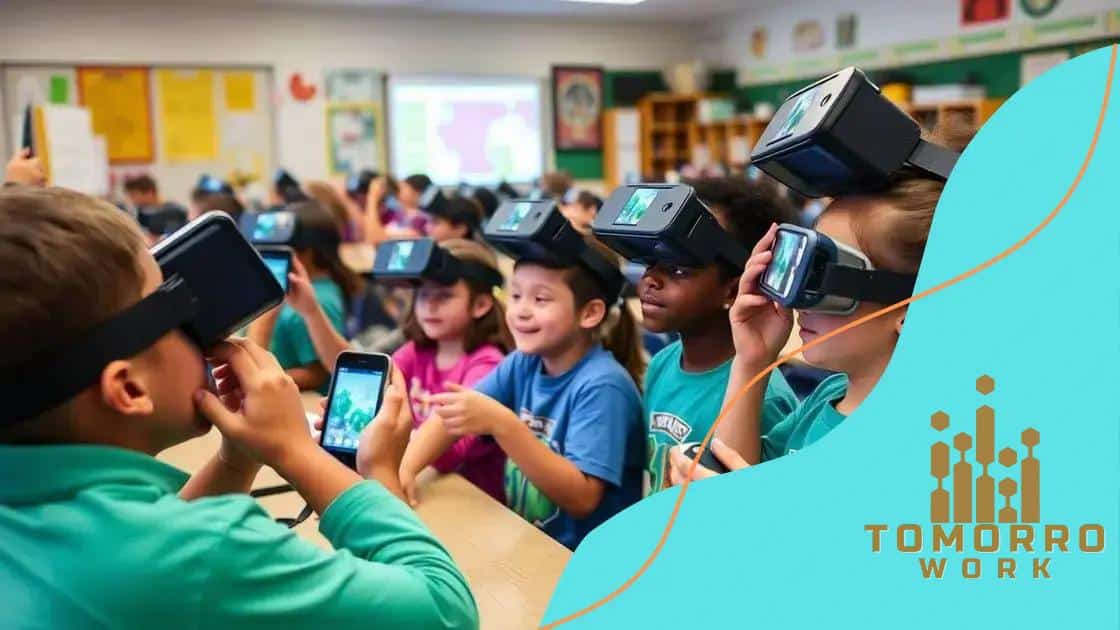
Augmented Reality (AR) in classrooms has paved the way for innovative teaching methods. Educators are discovering practical applications of AR that enrich the learning experience, making subjects come alive.
Virtual Field Trips
One exciting application of AR is in conducting virtual field trips. Students can explore places like ancient ruins or distant planets without leaving their classroom. Through AR, students can interact with historical sites and learn about them immersively, leading to better engagement and retention.
- Visit landmarks around the world.
- Explore geological formations in real-time.
- Engage with wildlife in natural habitats.
With AR, learning becomes a truly hands-on experience. Instead of merely learning about a topic in a textbook, students can visualize and interact with it, fostering deeper understanding.
Interactive Science Experiments
AR also transforms science education, allowing students to conduct experiments in a safe environment. They can observe chemical reactions or model complex structures like the human heart. This interactive approach helps to demystify challenging concepts and encourages inquiry-based learning.
For instance, an AR program can simulate a lab environment where students can manipulate variables and see real-time effects. This practical application not only makes learning fun but also provides a platform for critical thinking.
Language Learning
Another practical use of AR is in language learning. Students can engage with vocabulary in real-world contexts, enhancing their language acquisition. They can scan objects around the classroom to receive information and prompts in the target language, fostering immersive learning.
This interaction enables learners to practice speaking, reading, and listening skills in a dynamic way. By associating words with visual and interactive elements, students can retain vocabulary more effectively and develop confidence in using the language.
Customized Learning Experiences
AR can be tailored to meet individual learning needs. Teachers can create customized lessons that address the specific interests and abilities of each student. This personalized approach allows for a more inclusive classroom environment.
With AR, educators can provide differentiated instruction, ensuring all students access the curriculum in a way that suits them best. Through engaging visuals and interactive elements, learners feel motivated and supported.
Challenges and limitations of AR technology
While augmented reality (AR) offers exciting opportunities for education, it also presents several challenges and limitations that educators must consider. Understanding these obstacles is essential for effectively integrating AR into the classroom.
Technical Limitations
One common challenge is the technical limitations of AR devices. Not all students have access to the required technology, such as AR glasses or compatible smartphones. This disparity can create inequalities in learning experiences, as some students may miss out on the benefits of AR.
Content Quality
The effectiveness of AR in education depends heavily on the quality of the content available. If the AR applications are poorly designed or lack engaging material, students may lose interest quickly. Inconsistent content quality can undermine the learning experience and lead to frustration.
- Limited availability of educational AR applications.
- Dependence on internet connectivity for many AR tools.
- Variability in user experience based on device specifications.
Moreover, creating high-quality AR content can be resource-intensive. Teachers may require training to develop effective AR lessons, and not all schools have the necessary support to implement this technology successfully.
Potential Distractions
Another concern is that AR can sometimes distract students from traditional learning. The novelty of the technology might divert attention from the lesson itself, making it harder for students to focus on the subject matter. Balancing AR with conventional teaching methods is crucial to avoid this pitfall.
Additionally, students may encounter technical difficulties while using AR applications. These issues can lead to frustration and reduce the overall effectiveness of the lesson. Providing adequate support and troubleshooting resources is imperative to mitigate these challenges.
Safety and Privacy Concerns
Lastly, AR technology raises safety and privacy concerns. Educators must ensure that student data is protected when using AR applications. Many AR tools require user data for customization, which brings up questions about privacy and consent. Educators need to be vigilant in choosing tools that prioritize student safety.
In conclusion, while AR technology has the potential to transform education, it is essential to recognize the challenges and limitations. By addressing these issues, educators can create a more effective learning environment that maximizes the benefits of augmented reality.
Future trends in augmented reality education
The future of augmented reality (AR) in education looks promising, with several trends emerging that could transform the way we teach and learn. As technology continues to evolve, so do the possibilities for enhancing educational experiences through AR.
Increased Accessibility
One trend is the focus on increasing accessibility. More AR applications are being developed with user-friendly interfaces, making them easier for both teachers and students to use. This means that even those who are not tech-savvy can engage with AR effectively.
Integration with Artificial Intelligence
Another exciting trend is the integration of AR with artificial intelligence (AI). This combination can create personalized learning experiences. For example, AI can analyze student performance and suggest AR content tailored to their needs. Such tailored learning pathways can enhance comprehension and retention.
- Adaptive learning platforms that change based on student progress.
- Real-time feedback through AI-enhanced AR applications.
- Targeted challenges to improve specific skills.
This adaptive approach not only makes learning more interactive but also ensures that students receive the support they need to succeed.
Collaboration and Social Learning
Future AR platforms are expected to emphasize collaboration. With features that allow students to work together on AR tasks, learning becomes a shared experience. This social aspect is crucial because collaboration fosters engagement and helps students develop important teamwork skills.
As classrooms become more tech-savvy, we can expect more group projects that utilize AR. These projects will encourage communication and collective problem-solving, preparing students for real-world scenarios.
AR in Remote Learning
With the increase in remote learning, AR technology will likely play a significant role. It can bridge gaps in physical classrooms by providing immersive learning experiences that can be accessed from home. Students can participate in AR lessons that simulate physical interactions, making remote learning more impactful.
Through AR, distance learners can explore virtual labs or take virtual field trips that would otherwise be unattainable. This shift could lead to a more engaging remote learning experience, reducing feelings of isolation among students.
FAQ – Frequently Asked Questions about Augmented Reality in Education
What are the main advantages of using augmented reality in education?
Augmented reality enhances student engagement, improves retention of information, and provides interactive experiences that deepen understanding.
How does augmented reality cater to different learning styles?
AR supports visual learners with immersive visuals, auditory learners through interactive discussions, and kinesthetic learners by allowing hands-on interactions.
What challenges does augmented reality face in classroom settings?
Challenges include technical limitations, content quality issues, potential distractions, and safety concerns regarding student privacy.
How will augmented reality influence remote learning in the future?
AR is expected to bridge gaps in remote learning by offering immersive experiences that allow students to engage with content dynamically from home.


